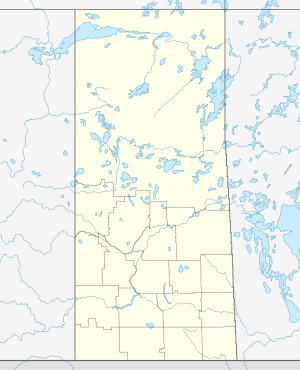Whitecap Dakota First Nation
Whitecap Dakota First Nation is a Dakota First Nations band government whose reserve is located 26 km (16 mi) south of Saskatoon, Saskatchewan, Canada. Governing the Whitecap Indian Reserve No. 94, historically referred to as the Moose Woods Sioux Reserve,[1] it is bordered by the Rural Municipality of Dundurn No. 314 and located along Highway 219 between the South Saskatchewan River and CFAD Dundurn.[3]
Whitecap 94 Whitecap Dakota First Nation | |
|---|---|
 Whitecap 94  Whitecap 94 | |
| Coordinates: 51°52′0″N 106°42′2″W | |
| Country | |
| Province | |
| Census division | 11 |
| Rural Municipality | Dundurn No. 314 |
| Incorporated | 1881 |
| Government | |
| • Chief | Darcy Bear |
| Area | |
| • Land | 16.774 km2 (6.476 sq mi) |
| Population (2017)[2] | |
| • Total | 322 |
| Time zone | UTC-6 (CST) |
Wapahaska (White Cap), a Dakota, was born in 1819 and died in 1889. In the 1850s White Cap had been a Headman of the Five Lodges Band, he was believed to have been a son or perhaps a nephew of Old Thunder Face. His group was an aggressive portion of that band that became designated as the Cankute or Shoot the Woods people. White Cap fled to Canada from Minnesota with Standing Buffalo after the so-called Minnesota Massacre of 1862. While in Canada Standing Buffalo and White Cap engaged a Metis trader by the name of Georges Racette to work for them and represent them in their negotiations with the Canadian government. On March 14, 1870 White Cap wrote a letter to Lt. Governor Adams Archibald of Fort Garry to inform him of his intentions to settle permanently on British territory. He said that he and his nation (presumably including Standing Buffalo's band) lived on English ground and had made peace with the Metis, Chippewa, Cree, and Assiniboine. After fleeing Minnesota in 1862, a number of Dakota Sioux who went to the North West Territory joined Metis buffalo hunting groups. James H. Howard notes: There was also a considerable band of Eastern Sioux under White Cap and the son of Standing Buffalo who ranged further west on the Qu’Appelle River in present Saskatchewan. When contacted by the treaty commissioners in 1875, White Cap informed them that his people had been in the region for thirteen years and that they wished to be left as they were, with the privilege of hunting with the Metis. They did not wish to settle on reserves with the other Sioux. [4]
Chief Wapahaska first selected a reserve near the elbow of the South Saskatchewan River at Aiktow, but because of the sandy soil in 1878, he moved north near the Metis settlement of Prairie Ronde, located in the Moose Woods, south of Saskatoon. This made his group neighbours to Charles Trottier's Metis Band. The two groups had hunted buffalo together on the plains for many years and Trottier was considered to be a Chief within the Dakota Sioux community. The two groups had also intermarried over the years and Trottier often referred to them as his cousins. Whitecap was given a reserve at Moose Woods in 1879 but it was not surveyed until 1881. [5]
As noted Chief Wapahaska (White Cap) and his band eventually settled along the South Saskatchewan River, and received a 16.774 km2 (6.476 sq mi) reserve in June 1881 despite not having signed a treaty.[1] The First Nation has a registered population of 656 people as of March 2017; approximately 322 members of the First Nation live on-reserve and approximately 334 live off-reserve.[2] The First Nation is led by Chief Darcy Bear and is affiliated with the Saskatoon Tribal Council.[6]
The Dakota Dunes Casino is located on Whitecap Dakota First Nation.
Whitecap, Saskatchewan
The unincorporated area of Whitecap is located within the Whitecap Dakota First Nation, located along Highway 219.[7]
References
- Thompson, Christian (2006). "Whitecap Dakota First Nation". The Encyclopedia of Saskatchewan. University of Regina. Retrieved September 28, 2017.
- "Registered Population: Whitecap Dakota First Nation". Indigenous and Northern Affairs Canada. Government of Canada. March 28, 2017. Retrieved September 28, 2017.
- MapArt Publishing Corp. Saskatchewan Road Atlas (Map) (2007 ed.). Oshawa, ON: Peter Heiler Ltd. p. 32. ISBN 1-55368-020-0.
- Barkwell, Lawrence. http://www.metismuseum.ca/media/document.php/11967.White%20Cap.pdf
- Barkwell, Lawrence. Op cit.
- "Chief & Council". Whitecap Dakota First Nation. Retrieved September 28, 2017.
- "Place names - Whitecap". Natural Resources Canada. Government of Canada. October 6, 2016. Retrieved September 28, 2017.